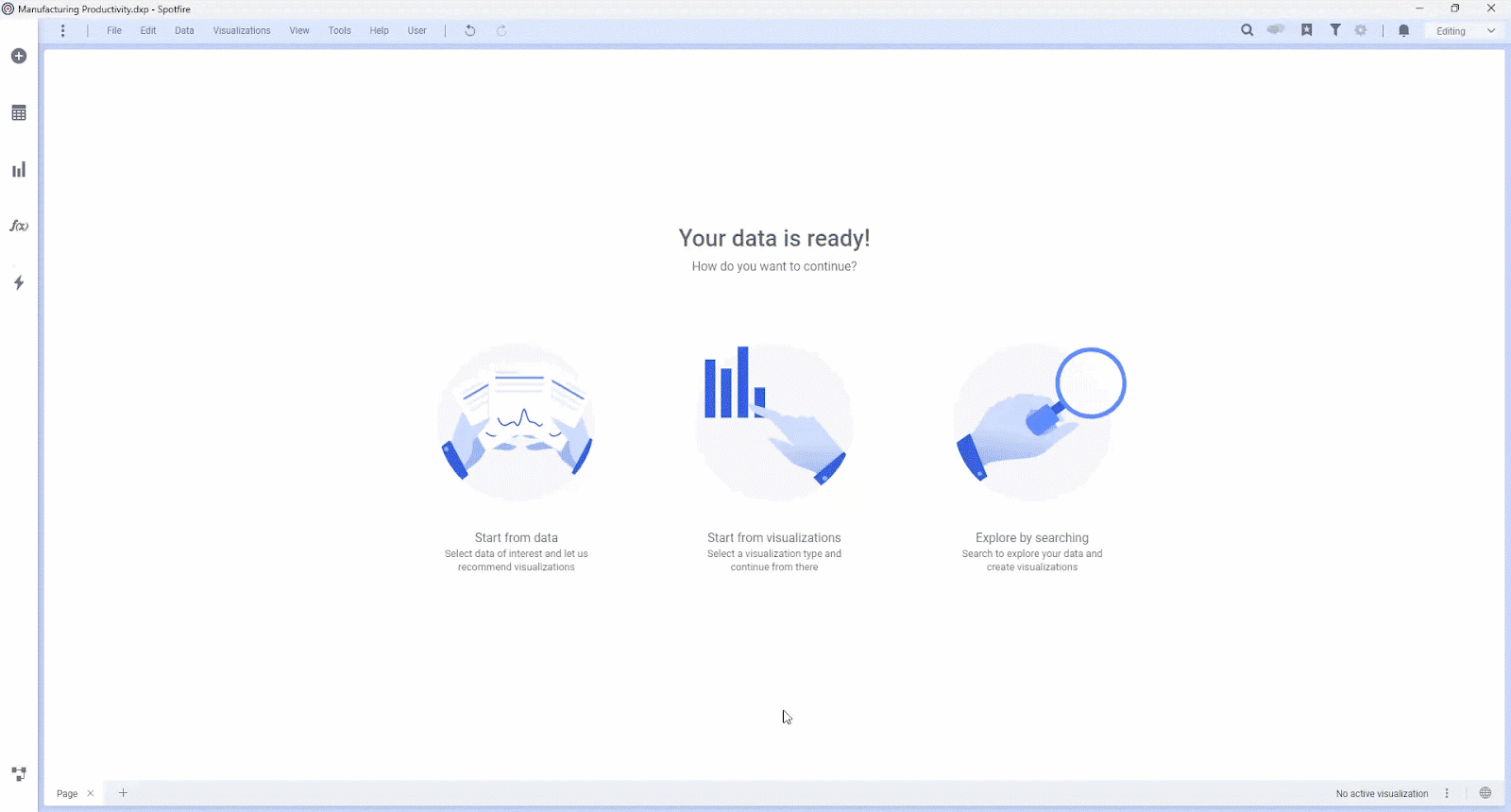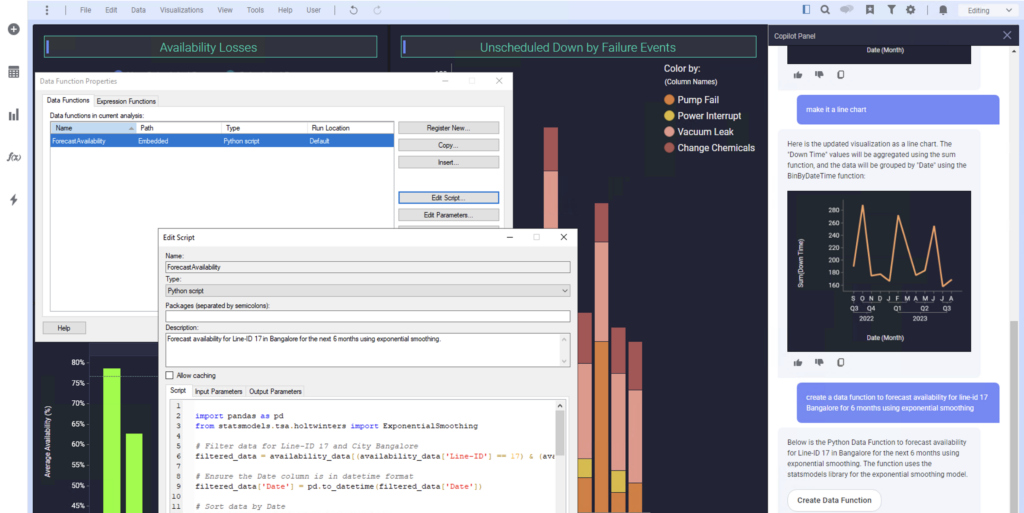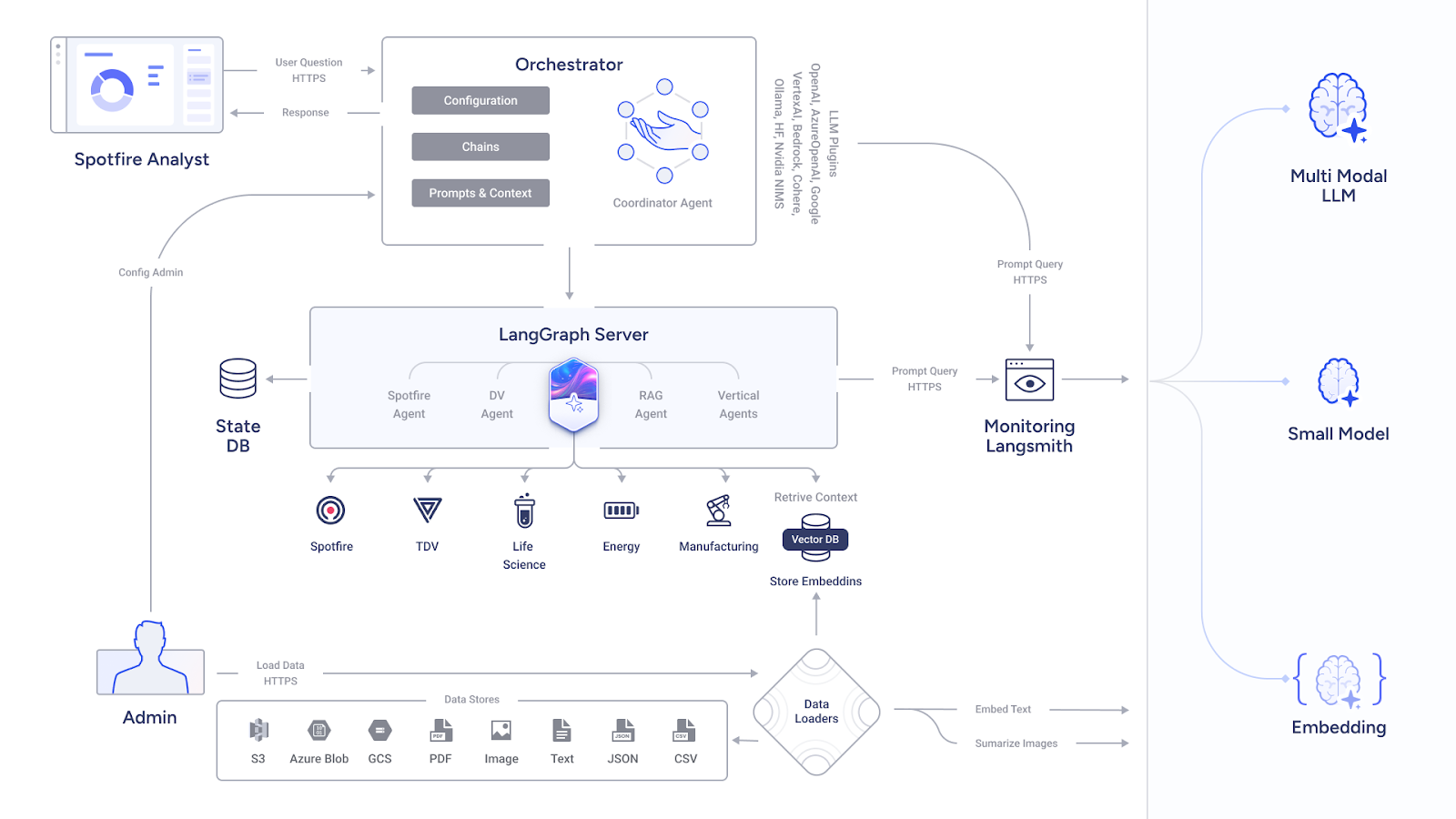
If you read my recent blog on the Gartner Data and Analytics Summit, you’ll remember all the hype around agentic AI, GenAI, and the rise of Gartner’s “perceptive analytics.” At Spotfire, we’ve been working in these areas since before the hype—launching our AI chat RAG application, the Spotfire CopilotTM assistant, in 2023 on top of Spotfire Recommendations, first released in 2018.
The Spotfire Copilot was created to rapidly extract insights from data, suggest actions, shorten the learning curve for non-Spotfire users, and drive efficiencies for all Spotfire users. It can generate interactive Spotfire visualizations and data science functions, interrogate your data, help you analyze and explain your data, and more. Spotfire Copilot Version 2.0 includes consumer browser users, all Spotfire visualizations, unlimited data science functions, explanations and storytelling, and incorporation of user and vertical documentation.
Spotfire AI: Behind the scenes
Our initial work included a continuously running AI-powered engine, the Spotfire® Recommendations Engine. This engine identifies multivariate relationships within the data and suggests visualizations that capture the insights and click into Spotfire. Recommendations are made from the data flyout, the data canvas, and elsewhere in the Spotfire experience. Data prep steps are also suggested.

Spotfire® Recommendations: OEE analysis—clicking on data in the flyout show multivariate associations of highlighted variables with the rest of the data, in optimal visualization formats. These are one-clicked into the visual canvas.
We released NLQ for visual generation at this time, enabling recommended visual analytics from user chat. Interactive invocation of the AI engine on a user-marking, was added soon after, in 2019, with insights for the marking (vs the rest of the data) being graphically displayed.
Spotfire Copilot was built upon the Spotfire Recommendations Engine early in the GenAI cycle via a solid relationship between Spotfire, Cloud Software Group, and Microsoft. After an informative MSFT Build 2023 conference, we implemented the Azure Open AI service, based on GPT3.5 with a simple workflow of: Input Text -> LLM -> Output Text and moved to what became RAG soon thereafter.
We moved to multimodal with GPT 4o in May 2024 as access to the latest data and read / write of the latest text, image, and video became the new frontier in GenAI. The workflow was then: multimodal input -> LLM + Tool use + RAGs -> Multi-modal output.
Spotfire Copilot 2.0 features advanced RAG functionality via a flyout from the right side of the Spotfire user experience. The Spotfire Copilot orchestrator models six tracks of user intents. These are general Q&A, Spotfire Q&A, and custom conversations based on internal documents—interrogating data, Spotfire visuals, and Spotfire code generation. I saw Q&A, conversations, and data interrogation in other products at Gartner—but I did not see visualization and code generation or chart/analysis explanation as rich as the Spotfire Copilot in any other vendor solution at the Gartner D&A Summit.

Spotfire Copilot: Interactive visualizations and data science function generation. In this figure, the Python code is generated, embedded into the Spotfire data function control, and saved to the Spotfire library. As it runs in the analysis, it generates a workflow lineage for governed reuse.
Agentic AI and Spotfire
We are currently introducing agentic AI components into the Spotfire Copilot architecture targeted to the more diverse and complex areas in the Spotfire platform and on specific industry vertical use cases. We have started with Spotfire® Advanced Data Services (ADS)—a separate data access layer where data can be centrally managed, modeled, provisioned, and analyzed without movement. With ADS, users can find, understand, and consume data from a single source, and a catalog of virtual views can be managed and sourced to the Spotfire analytics layer.
We are also developing AI Agents for specialized industrial applications, starting with our Energy and Manufacturing practices. One example is the analysis of Daily Drilling Reports (DDRs) stored in PDF format. The Spotfire DDR Agent enables users to ask natural language questions about specific wellbores over a selected time period. It delivers precise and contextualized responses by leveraging a Knowledge Graph to model relationships between entities such as wellbores, dates, operations, and reported metrics across the corpus. By combining the Spotfire Copilot RAG and Knowledge Graph, accurate summaries and rich insights pertaining to drilling metrics, challenges, and performance trends are generated. These rapidly generated insights assist field engineers in their around-the-clock decision-making.
The Spotfire Copilot and AI agents are well-suited to these diverse data layer challenges, given the complexities of available data and the multi-faceted desires of Spotfire authors. Spotfire® Enterprise includes real-time data streams, data services, and compute capabilities where this approach is relevant. We anticipate Spotfire AI agents evolving to collaborate with other AI agents and/or customers adding their own agents as we invoke functionalities across the data management and analytics landscape.
Throughout our GenAI journey, we’ve been using the toolset from LangChain—initially for chaining our RAG componentry and generating structured outputs, then for monitoring our deployment with LangSmith. This enables us to implement a tight FinOps solution for efficient usage by our customers. We are now using LangGraph in our development of fit-for-purpose AI Agents, combining user requests and data updates with APIs and other tools for taking actions.
After setting up Spotfire Copilot in Azure, we migrated it to GCP and AWS, featuring Vertex AI / Gemini and Bedrock / Claude respectively. We’ve also qualified the Copilot with other LLMs and several vector databases, including on-premises options. And we are now also using AI agent frameworks from the hyperscalers and the recent Open-AI release in addition to LangGraph…it’s a fast-moving landscape!

Spotfire Copilot architecture
Who benefits from the Copilot?
Visual data science, the heartbeat of Spotfire, is a key tool for engineers, scientists, quants, AI engineers, and developers. Business users experience guided viewing of resulting industrial applications, while data science developers use the Spotfire Copilot to create visual and data science components and build applications. Visual data scientists and developers get a big leg up from the Spotfire Copilot in code generation, especially with Spotfire data functions for data management, data preparation, and machine learning.
We are currently targeting these industrial engineering personas, while enabling data-savvy business users to evolve into data scientists and data scientists to evolve into developers and AI engineers.
Here’s one example of how the Copilot can take on Overall Equipment Effectiveness:
We are currently focused on industrial applications, including Statistical Process Control SPC and OEE. The SPC example illustrates the generation of a Spotfire data function for CPK. The OEE example includes functionality for loading additional data modules—user specified and/or vertical compendiums.
Get started with Spotfire Copilot
Spotfire Copilot 2.0, recently updated, can be downloaded from the Spotfire Community. We are building out many other industry vertical use cases and would like to hear from you in this regard. Let us know what you think about the recent release available on the Community!
For more on the latest in AI agents, follow my LinkedIn and Spotfire’s LinkedIn.